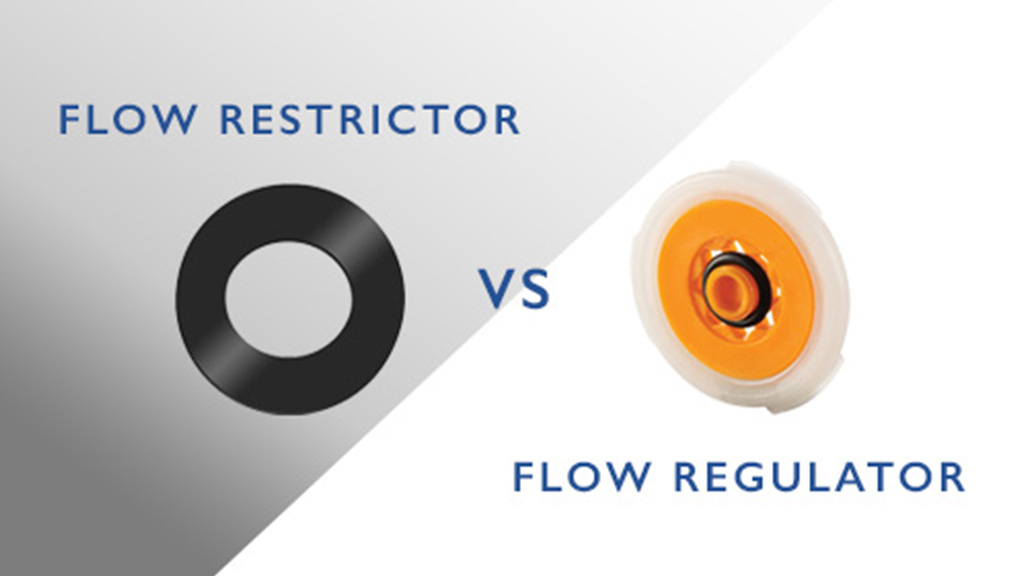27 February 2023
Reading time: 3 minutes
The purpose of a flow control valve is to manage water flow in showers and taps. Not only does the device control the movement of water, but it contributes to saving water because it limits the quantity of water exiting the shower head or tap spout.
A flow restrictor and a flow regulator are both flow control valves, but there is a difference in how these devices operate to limit the water passing through
We will explain how a flow restrictor works in showers and taps compared to a flow regulator, how each valve controls water flow and how you can determine the flow rate.

Click Here to see our Learning Hub.

How does a flow restrictor work?
A flow restrictor is a solid ring (small enough to fit inside a shower or tap pipe) with a fixed aperture. Picture a mini doughnut. Because of its stable structure that does not change in size, the flow restrictor constantly limits the water stream resulting in less water passing through the pipe before exiting. Thus, it also controls the quantity of water used.
How to determine the flow rate with a water flow restrictor valve
You have to know the pressure bar to figure out the flow rate (litres p/m) because if the pressure goes up, the flow rate goes up. It is the same concept when the pressure goes down because the flow rate will go down.
To explain this further, let us look at an example: at 3 bar, your flow rate is 6 litres p/m, but if the pressure increases to 6 bar, there will be more water flowing through the hole in the flow restrictor at a faster pace. But if the pressure in the building drops to 1 bar, the flow rate will drop to 2 litres p/m. This situation is not ideal because that is simply not enough water.

What does a flow regulator do?
A flow regulator in taps and showers normalises the water flow. Unlike a flow restrictor, this flow control valve keeps the water flow constant across different pressures. So, no matter the pressure level pushing the water through, the flow regulator always provides a consistent flow rate.

Typically a flow regulator has a plastic exterior with inner indentations and a unique type of rubber washer inside the ring. Sometimes, flow regulators may come with a main cartridge which is just a way of housing the device.
How does a flow regulator control the quantity of flowing water?
The rubber washer inside the ring expands and contracts based on the force of water pressure compressing it.
- Pressure builds
If the pressure builds up, the rubber expands into the inner indentations of the regulator (essentially closing the holes) and limits the volume of water trying to push through. - Pressure drops
When the pressure drops, the rubber washer contracts to allow more water to pass through. - Pressure stabilises
When the pressure stabilises, the rubber washer returns to its primary position enabling the correct flow rate to pass through it.
How to determine the flow rate with a flow regulator in taps and showers?
Each flow regulator is manufactured for a particular flow rate, for example, a 3 litres/min regulator or 6 litres/min regulator. Flow regulators are made accurately, but there are about 20 – 30 variations of one flow regulator designed for one flow rate because the rubber can vary in density amongst different manufacturers.

Where are the valves located?

Flow regulators and flow restrictors are typically in the water pipe behind the tap, but in most cases, you could fit a water control valve somewhere in a tap or tap outlet. Flow regulators can also fit into aerators.

Controlling the water flow in showers and taps
Whether you install a flow restrictor or a flow regulator in showers and taps, both valves will control the water flow. The difference between the two is in the functionality of how they alter water flow and the effects of how high or low pressure will impact the flow rate.
The flow restrictor limits the volume of water with its stable and fixed structure, whereas the flow regulator normalises the water flow with its contracting and expanding rubber washer.
To determine the flow rate with a flow restrictor, you must know the pressure you are getting in the pipes. With a flow regulator, it does not matter whether the pressure is high or low because it still allows a consistent stream of water to pass through as the rubber washer adjusts.
Do you know which flow control valve is best for your showers and taps? We encourage you to reach out to our commercial washroom specialists, who will be happy to explain the advantages and disadvantages of both valves so that you can make an informed decision.




